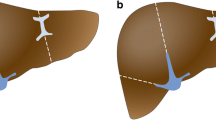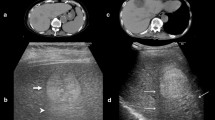Abstract
Purpose
To evaluate associations between pathology and CT assessments made according to the mRECIST in HCC treated by conventional TACE (cTACE), and to identify predictors of complete tumor necrosis.
Methods
From March 2016 to July 2018, 83 patients with a total of 100 masses were retrospectively included. Patients underwent sequential cTACE and portal vein embolization, and later hepatic surgery. Evaluation of treatment response and measurement of baseline lipiodol accumulation as mean HU was performed on CT at the time point closest to the time of operation (mean, 54.5 days after cTACE). Significant predictors associated with complete necrosis were identified by multivariate analysis. The optimal cut-off HU value of lipiodol accumulation for prediction of complete necrosis was determined using a ROC analysis.
Results
According to mRECIST, complete response (CR, n = 70) and partial response (n = 30) were classified. 34.3% (24/70) masses classified as CR according to mRECIST were found to have viable lesions on pathology. On multivariate analysis, mean HU of lipiodol accumulation was the only significant predictor of complete necrosis (p = .003, odds ratio 1.746, 95% CI 1.201–2.539). On ROC analysis, 460 HU as a cut-off value was significantly associated with complete necrosis (67.4% sensitivity, 75.0% specificity).
Conclusions
A threshold value for lipiodol accumulation > 460 HU was highly sensitive and specific for complete necrosis, even in complete response according to mRECIST. Therefore, if lipiodol accumulation is insufficient in post-TACE CT, recurrence should be monitored more sensitively.





Similar content being viewed by others
Availability of data and material
Due to ethical restrictions, the raw data underlying this paper are available upon request to the corresponding author.
Abbreviations
- PVE:
-
Portal vein embolization
- AVP:
-
Amplatzer vascular plug
- NBCA:
-
n-Butyl cyanoacrylate
- CR:
-
Complete response
- PR:
-
Partial response
- FLR:
-
Future liver remnant
- BCLC:
-
Barcelona clinic liver cancer
- AFP:
-
Serum alpha-fetoprotein
- PIVKA-II:
-
Protein induced by vitamin K absence-II
- LC:
-
Liver cirrhosis
- HBV:
-
Hepatitis B virus
- HCV:
-
Hepatitis C virus
- NBNC:
-
Non-B, non-C liver cirrhosis
- PVT:
-
Portal vein thrombus
- SD:
-
Standard deviation
- IQR:
-
Interquartile range
- FU:
-
Follow up
References
Bray F, Ferlay J, Soerjomataram I, et al. (2018) Global cancer statistics 2018: GLOBOCAN estimates of incidence and mortality worldwide for 36 cancers in 185 countries. CA Cancer J Clin 68:394–424. https://doi.org/10.3322/caac.21492
Takayasu K (2013) Transcatheter arterial chemoembolization for unresectable hepatocellular carcinoma: recent progression and perspective. Oncology 84(Suppl 1):28–33. https://doi.org/10.1159/000345886
Lencioni R, Petruzzi P, Crocetti L (2013) Chemoembolization of hepatocellular carcinoma. Semin Intervent Radiol 30:3–11. https://doi.org/10.1055/s-0033-1333648
Lo CM, Ngan H, Tso WK, et al. (2002) Randomized controlled trial of transarterial lipiodol chemoembolization for unresectable hepatocellular carcinoma. Hepatology 35:1164–1171. https://doi.org/10.1053/jhep.2002.33156
Haywood N, Gennaro K, Obert J, et al. (2016) Does the Degree of Hepatocellular Carcinoma Tumor Necrosis following Transarterial Chemoembolization Impact Patient Survival? J Oncol 2016:4692139. https://doi.org/10.1155/2016/4692139
Takayasu K, Arii S, Matsuo N, et al. (2000) Comparison of CT findings with resected specimens after chemoembolization with iodized oil for hepatocellular carcinoma. AJR Am J Roentgenol 175:699–704. https://doi.org/10.2214/ajr.175.3.1750699
Forner A, Llovet JM, Bruix J (2012) Hepatocellular carcinoma. Lancet 379:1245–1255. https://doi.org/10.1016/S0140-6736(11)61347-0
Lencioni R (2010) Loco-regional treatment of hepatocellular carcinoma. Hepatology 52:762–773. https://doi.org/10.1002/hep.23725
Forner A, Ayuso C, Varela M, et al. (2009) Evaluation of tumor response after locoregional therapies in hepatocellular carcinoma: are response evaluation criteria in solid tumors reliable? Cancer 115:616–623. https://doi.org/10.1002/cncr.24050
Yaghmai V, Besa C, Kim E, et al. (2013) Imaging assessment of hepatocellular carcinoma response to locoregional and systemic therapy. AJR Am J Roentgenol 201:80–96. https://doi.org/10.2214/AJR.13.10706
Murakami T, Nakamura H, Hori S, et al. (1993) Detection of viable tumor cells in hepatocellular carcinoma following transcatheter arterial chemoembolization with iodized oil: pathologic correlation with dynamic turbo-FLASH MR imaging with Gd-DTPA. Acta Radiol 34:399–403
Sato Y, Watanabe H, Sone M, et al. (2013) Tumor response evaluation criteria for HCC (hepatocellular carcinoma) treated using TACE (transcatheter arterial chemoembolization): RECIST (response evaluation criteria in solid tumors) version 1.1 and mRECIST (modified RECIST): JIVROSG-0602. Ups J Med Sci 118:16–22. https://doi.org/10.3109/03009734.2012.729104
Bargellini I, Bozzi E, Campani D, et al. (2013) Modified RECIST to assess tumor response after transarterial chemoembolization of hepatocellular carcinoma: CT-pathologic correlation in 178 liver explants. Eur J Radiol 82:e212–218. https://doi.org/10.1016/j.ejrad.2012.12.009
Dioguardi Burgio M, Ronot M, Bruno O, et al. (2016) Correlation of tumor response on computed tomography with pathological necrosis in hepatocellular carcinoma treated by chemoembolization before liver transplantation. Liver Transpl 22:1491–1500. https://doi.org/10.1002/lt.24615
Imaeda T, Yamawaki Y, Seki M, et al. (1993) Lipiodol retention and massive necrosis after lipiodol-chemoembolization of hepatocellular carcinoma: correlation between computed tomography and histopathology. Cardiovasc Intervent Radiol 16:209–213
Kwan SW, Fidelman N, Ma E, Kerlan RK Jr, Yao FY (2012) Imaging predictors of the response to transarterial chemoembolization in patients with hepatocellular carcinoma: a radiological-pathological correlation. Liver Transpl 18:727–736. https://doi.org/10.1002/lt.23413
Choi BI, Kim HC, Han JK, et al. (1992) Therapeutic effect of transcatheter oily chemoembolization therapy for encapsulated nodular hepatocellular carcinoma: CT and pathologic findings. Radiology 182:709–713. https://doi.org/10.1148/radiology.182.3.1311116
Matsui Y, Horikawa M, Jahangiri Y, et al. (2016) Degree of baseline lipiodol accumulation after transarterial chemoembolization for hepatocellular carcinoma: identification of a threshold value predicting tumor response [abstract 183]. J Vasc Interv Radiol 27(3 suppl):S85–S86. https://doi.org/10.1016/j.jvir.2015.12.227
Choi JH, Hwang S, Lee YJ, Kim KH, Ko GY, Gwon DI, et al. (2015) Prognostic effect of preoperative sequential transcatheter arterial chemoembolization and portal vein embolization for right hepatectomy in patients with solitary hepatocellular carcinoma. Korean J Hepatobiliary Pancreat Surg 19:59-65. https://doi.org/10.14701/kjhbps.2015.19.2.59
Ogata S, Belghiti J, Farges O, et al. (2006) Sequential arterial and portal vein embolizations before right hepatectomy in patients with cirrhosis and hepatocellular carcinoma. Br J Surg 93:1091–1098. https://doi.org/10.1002/bjs.5341
Ko GY, Sung KB, Yoon HK, et al. (2003) Preoperative portal vein embolization with a new liquid embolic agent. Radiology 227:407–413. https://doi.org/10.1148/radiol.2272011702
Yoo H, Ko GY, Gwon DI, et al. (2009) Preoperative portal vein embolization using an amplatzer vascular plug. Eur Radiol 19:1054–1061. https://doi.org/10.1007/s00330-008-1240-2
Kim SH, Lee WJ, Lim HK, Lim JH (2007) Prediction of viable tumor in hepatocellular carcinoma treated with transcatheter arterial chemoembolization: usefulness of attenuation value measurement at quadruple-phase helical computed tomography. J Comput Assist Tomogr 31:198–203. https://doi.org/10.1097/01.rct.0000236424.20514.2e
Kubota K, Hisa N, Nishikawa T, et al. (2001) Evaluation of hepatocellular carcinoma after treatment with transcatheter arterial chemoembolization: comparison of Lipiodol-CT, power Doppler sonography, and dynamic MRI. Abdom Imaging 26:184–190
El Bacha H, Salihoun M, Kabbaj N, Benkabbou A (2017) Complete necrosis of hepatocellular carcinoma after preoperative portal vein embolization: a case report. J Med Case Rep 11:7. https://doi.org/10.1186/s13256-016-1160-8
de Graaf W, van den Esschert JW, van Lienden KP, van Gulik TM (2009) Induction of tumor growth after preoperative portal vein embolization: is it a real problem? Ann Surg Oncol 16:423–430. https://doi.org/10.1245/s10434-008-0222-6
Funding
There were no funding sources.
Author information
Authors and Affiliations
Corresponding author
Ethics declarations
Conflict of interest
The authors have no conflicts of interest to report.
Additional information
Publisher's Note
Springer Nature remains neutral with regard to jurisdictional claims in published maps and institutional affiliations.
Rights and permissions
About this article
Cite this article
Park, C., Gwon, D.I., Chu, H.H. et al. Correlation of tumor response on CT with pathologically proven necrosis in hepatocellular carcinoma treated by conventional transcatheter arterial chemoembolization: threshold value of intratumoral Lipiodol accumulation predicting tumor necrosis. Abdom Radiol 46, 3729–3737 (2021). https://doi.org/10.1007/s00261-020-02845-4
Received:
Revised:
Accepted:
Published:
Issue Date:
DOI: https://doi.org/10.1007/s00261-020-02845-4




